Attached files
| file | filename |
|---|---|
| 8-K - FORM 8-K - ABEONA THERAPEUTICS INC. | v425980_8k.htm |
EXHIBIT 99.1

NASDAQ: ABEO www.abeonatherapeutics.com 1

Safe Harbor Statement This presentation contains certain statements that may be forward - looking within the meaning of Section 27a of the Securities Act of 1933, as amended, including statements relating to the product portfolio and pipeline and clinical programs of the company, the market opportunities for the all of the company’s products and product candidates, and the company ’ s goals and objectives. These statements are subject to numerous risks and uncertainties, including but not limited to the risks detailed in the Company’s Annual Report on Form 10 - K for the year ended December 31, 2014, and other reports filed by the company with the Securities and Exchange Commission. This presentation does not constitute an offer or invitation for the sale or purchase of securities or to engage in any other transaction with Abeona Therapeutics or its affiliates. The information in this presentation is not targeted at the residents of any particular country or jurisdiction and is not intended for distribution to, or use by, any person in any jurisdiction or country where such distribution or use would be contrary to local laws or regulations. The Company undertakes no obligations to make any revisions to the forward - looking statements contained in this presentation or to update them to reflect events or circumstances occurring after the date of this presentation, whether as a result of new information, future developments or otherwise. 2

Abeona Therapeutics : Developing Therapies for Children with Rare Genetic Diseases 3 • Pronunciation : a y - bee - oh - n uh • Origin : Roman Goddess said to be the protector of children as they start out on their journey • Focus : Abeona Therapeutics develops and delivers gene therapy and plasma - based products for severe and life - threatening rare diseases Janette and Inaki , MPS IIIA
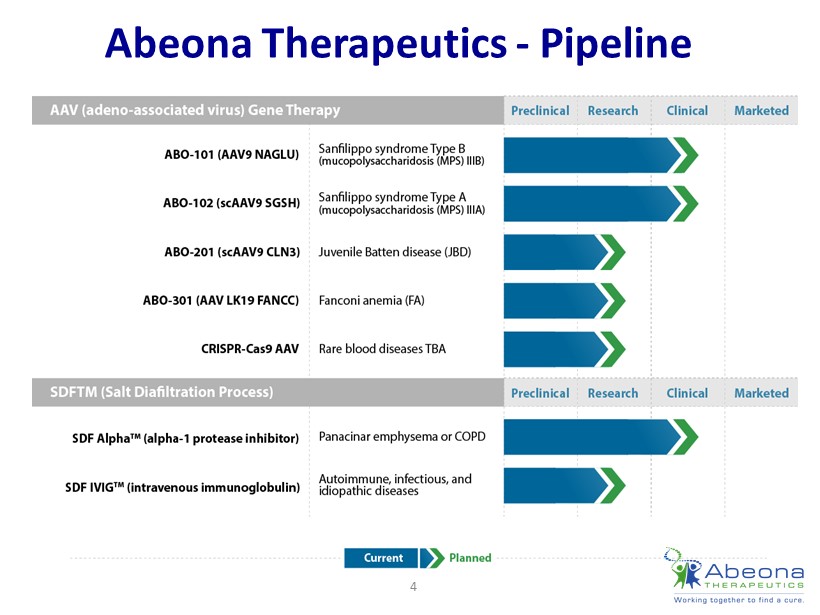
Abeona Therapeutics - Pipeline 4

GENE THERAPY 5

Lysosomes : an organelle in the cytoplasm of animal cells containing degradative enzymes enclosed in a membrane 6 Normal cell Cell with lysosome deficiency • Lysosomes serve as cell recycling center • Uses enzymes to break down sugars • Genetic defects can cause enzymes to not function properly • This causes buildup in the lysosome of unbroken down sugars (GAGs) • Class of lysosomal storage disorders (LSDs)

Potential Routes of Delivery for AAV Gene Therapy 7 Intravenous: Injection into a blood vessel • Whole body delivery for treatment of multiple organs systems, including brain • Strong patient adoption, low safety risk • Abeona’s approach utilizes AAV9 for treating lysosomal storage diseases Intracerebral : Direct injection into the brain • Requires holes drilled into skull • Minimal peripheral organ delivery Intrathecal : Direct injection into the spinal cord • Spinal injections • Minimal peripheral organ delivery

Delivery of AAV9 by intravenous delivery crosses the blood - brain barrier with broad coverage • Single, intravenous AAV9 injection • Expressed in multiple nervous system cell types • Supra - physiological enzyme expression in brain for over a year observed in animals • Self - complementary AAV9 (scAAV9) persists as a stable episome in non - dividing cells with transgene expression for years • scAAV9 vectors are 10 - 100 - fold more efficient than traditional single - stranded ( ss ) AAV vectors • Robust, uniform expression in all areas of brain and peripheral tissues scAAV9 - GFP expression in whole brain of juvenile Batten disease mouse after intravenous injection at 5 months post - injection Sources: Keilan et al lab.; Eliason SL, Stein CS, Mao Q, et al. A knock - in reporter model of Batten disease. J Neurosci . 2007;27(37):9826 - 9834. 8

Sanfilippo Syndrome ( MPS IIIB & MPS IIIA) 9
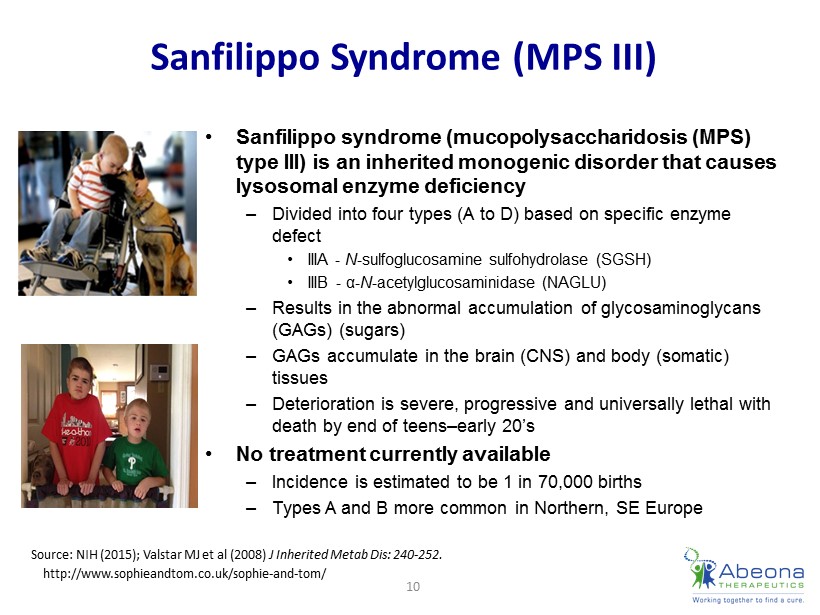
Sanfilippo Syndrome (MPS III) • Sanfilippo syndrome ( mucopolysaccharidosis (MPS) type III ) is an inherited monogenic disorder that causes lysosomal enzyme deficiency – Divided into four types (A to D) based on specific enzyme defect • IIIA - N - sulfoglucosamine sulfohydrolase (SGSH) • IIIB - α - N - acetylglucosaminidase ( NAGLU) – Results in the abnormal accumulation of glycosaminoglycans (GAGs) (sugars) – GAGs accumulate in the brain (CNS) and body (somatic) tissues – Deterioration is severe , progressive and universally lethal with death by end of teens – early 20’ s • No treatment currently available – Incidence is estimated to be 1 in 70,000 births – Types A and B more common in Northern , SE Europe Source: NIH (2015); Valstar MJ et al (2008) J Inherited Metab Dis: 240 - 252. http:// www.sophieandtom.co.uk / sophie - and - tom/ 10

Abeona’s Gene Therapy: Whole body treatment by intravenous injection 11 AAV9 virus Intravenous injection Whole - body correction • Increased enzyme activity • Normalized GAG content • Neuromuscular correction • Cognitive improvements • 100% improved survival 4 – 6 week old MPS III animals 4 – 6 month old MPS III animals Non - human primates (safety) LSD affect all organs

IV Delivery of ABO - 101 Induces Clearance of Lysosomal GAG Storage in the CNS and Somatic Tissues rAAV9 - mediated rNAGLU expression in MPS IIIB mouse brain • NAGLU expression at or above heterozygote (and often above wild - type) 12 16 - 27 mo pi

IV Delivery of ABO - 101 Induces Clearance of Lysosomal GAG Storage in the CNS and Somatic Tissues Lower bars are better. Demonstrates that treated IIIB mice have reduced GAG content, similar to unaffected animals, in multiple tissues compared to untreated IIIB mice (with exception of kidney). 13 Source: Fu et al (2011) Correction of Neurological Disease of Mucopolysaccharidosis IIIB in adult mice by rAAV9 Trans - Blood - Brain Barrier Gene Delivery , Mol. Ther 19

AB0 - 101 Demonstrates Normalization of Cognitive and Motor Function in 4 - 6 Week Old MPS IIIB Mice Hidden task in Morris water maze Latency to fall from a rotarod 14 Source: Fu et al (2011) Correction of Neurological Disease of Mucopolysaccharidosis IIIB in adult mice by rAAv9 Trans - Blood - Brain Barrier Gene Delivery , Mol. Ther 19

Single iv Infusion of AB0 - 101 at 4 – 6 Weeks of Age Normalized The Survival in MPS IIIB Mice 15 Survival (rAAV9 - CMV - hNAGLU) Source: Fu et al (2011) Correction of Neurological Disease of Mucopolysaccharidosis IIIB in adult mice by rAAv9 Trans - Blood - Brain Barrier Gene Delivery , Mol. Ther 19

Persistence of NAGLU (MPS IIIB enzyme) Activity in CNS 6 Months post - intravenous injection in Non - Human Primates Brain and somatic NAGLU activity is significantly increased over normal enzyme levels 6 months post - injection despite modest decreases in peripheral serum NAGLU levels Source: Murrey et al (2014) Feasibility and Safety of Systemic rAAV9 - hNAGLU Delivery for Treating Mucopolysaccharidosis IIIB: Toxicology , Biodistribution, and Immunological Assessments in Primates , Hum. Gene Ther . 25:72 - 84 16
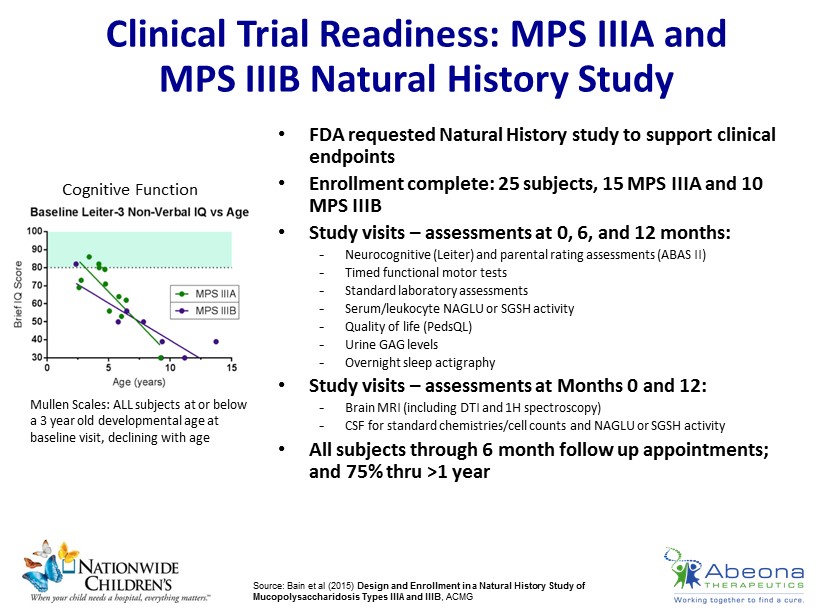
Clinical Trial Readiness: MPS IIIA and MPS IIIB Natural History Study • FDA requested Natural History study to support clinical endpoints • Enrollment complete: 25 subjects, 15 MPS IIIA and 10 MPS IIIB • Study visits – assessments at 0, 6, and 12 months: - Neurocognitive ( Leiter ) and parental rating assessments (ABAS II) - Timed functional motor tests - Standard laboratory assessments - Serum/leukocyte NAGLU or SGSH activity - Quality of life ( PedsQL ) - Urine GAG levels - Overnight sleep actigraphy • Study visits – assessments at Months 0 and 12: - Brain MRI (including DTI and 1H spectroscopy) - CSF for standard chemistries/cell counts and NAGLU or SGSH activity • All subjects through 6 month follow up appointments; and 75% thru >1 year 17 Mullen Scales: ALL subjects at or below a 3 year old developmental age at baseline visit, declining with age Cognitive Function Source: Bain et al (2015) Design and Enrollment in a Natural History Study of Mucopolysaccharidosis Types IIIA and IIIB , ACMG

Phase 1/2 open - label, dose - escalation clinical trial of ABO - 101 (AAV9 NAGLU) for MPS IIIB • Two dose cohorts of n=6 - 9 pts via intravenous injection • Primary objective is determination of safety, with secondary objectives: • CSF and serum NAGLU enzyme activity levels. • Improved cognitive ability or stalled cognitive deterioration at 6 months after treatment ( Leiter International Performance assessment) • Parent ratings of adaptive functioning (Adaptive Behavior Assessment System) • Parental ratings of motional/behavioral problems ( Child Behavioral Checklist) • Reduced hepatomegaly and splenomegaly at 6 months after treatment by MRI . • Pediatric Quality of Life Inventory 4.0 ( PedsQL ) • Inclusion criteria • Age 2 years old or greater • Confirmed diagnosis of MPS IIIB by either: – No detectable or significantly reduced NAGLU enzyme activity by plasma, serum, or leukocyte assay. – Genomic DNA mutation analysis demonstrating a homozygous or compound heterozygous mutations in the NAGLU gene • Clinical history of or examination features of neurologic dysfunction. • Multiple global Phase 1/2 studies with n=~30 pts 18 Clearance of lysosomal storage pathology in the liver of MPS IIIB mice 6 months after an IV rAAV9.NAGLU infusion
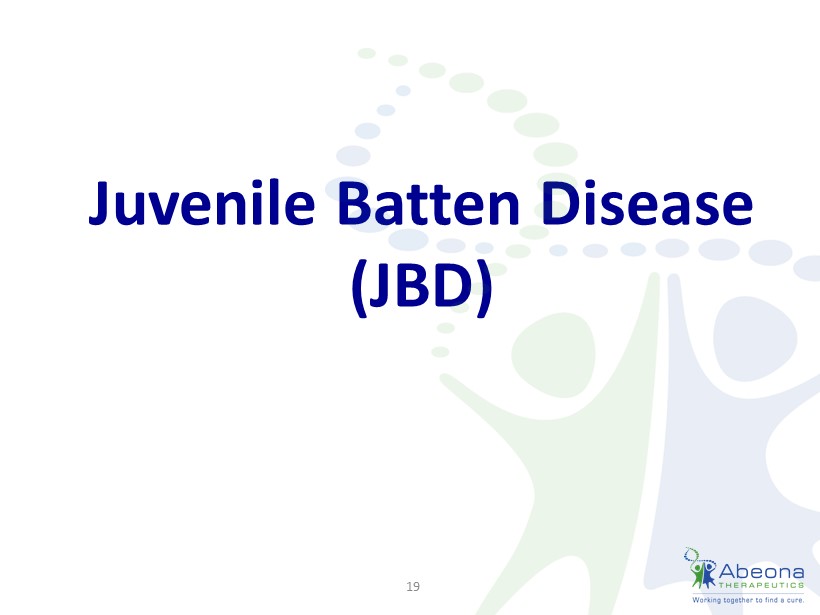
Juvenile Batten Disease (JBD) 19

Juvenile Batten Disease (Juvenile Neuronal Ceroid Lipofuscinosis ) • Autosomal recessive (inherited) mutation in the CLN3 gene; estimated incidence of 1:100,000 births • Lysosomal storage disease characterized by the accumulation of autofluorescent ceroid lipopigments and proteins • Initially presents as blindness, progressing to behavioral issues, sleep disturbances, seizures, cognitive loss, motor abnormalities, and premature death (late teens - early 20s ) • Neurodegeneration occurs primarily in thalamus, cortex, and hippocampus, although inclusion are observed throughout the CNS Source: Moving towards therapies for Juvenile batten disease? Experimental Neurology, 2008 12 years 17 years Inclusion formation 20
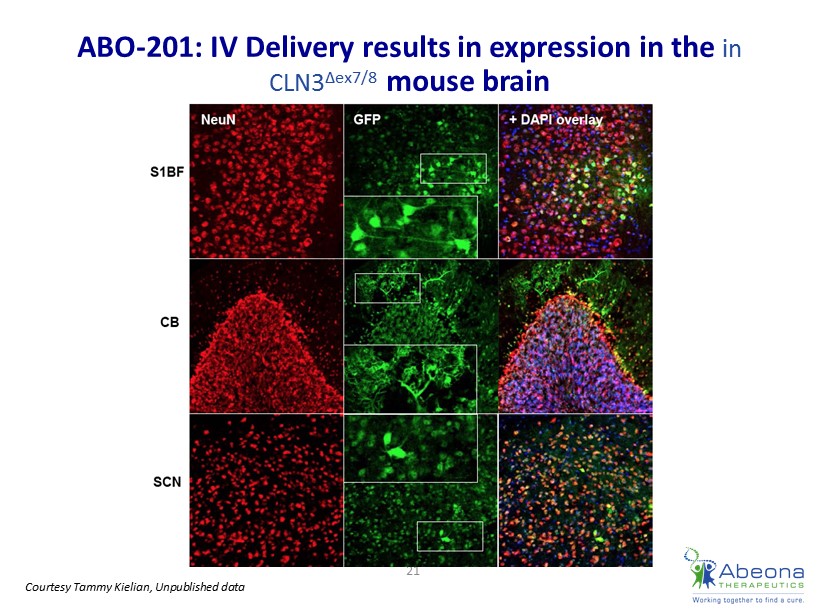
ABO - 201: IV Delivery results in expression in the in CLN3 Δex7/8 mouse brain 21 Courtesy Tammy Kielian , Unpublished data

Motor behavior is normalized in CLN3 mice treated with intravenous injection of ABO - 201 3 months post - injection Courtesy Tammy Kielian , Unpublished data

CRISPR Cas9 Gene Editing for Rare Blood Diseases • CRISPRs (clustered regularly interspaced short palindromic repeats) are segments of DNA that contain short repeating base pairs • Cas9 is an enzyme specialized for cutting DNA, enabling gene editing to insert, replace or remove genetic information • Unique AAV LK19 hematopoetic tropism gene therapy • Fanconi anemia (FA ) proof of concept in multiple models including : – FANCC in human fibroblasts – ABO - 301 (FANCC AAV LK19) in vivo • Broad technology platform and IP for non - oncology blood disorders including Fabry’s , beta thalassemia, inherited forms of neutropenia, thrombocytopenia, and anemias AAV Gene therapy Targeted Genome Editing DNA Repair Genomic DNA Guide RNA Cas9 Matching Genomic Sequence 23
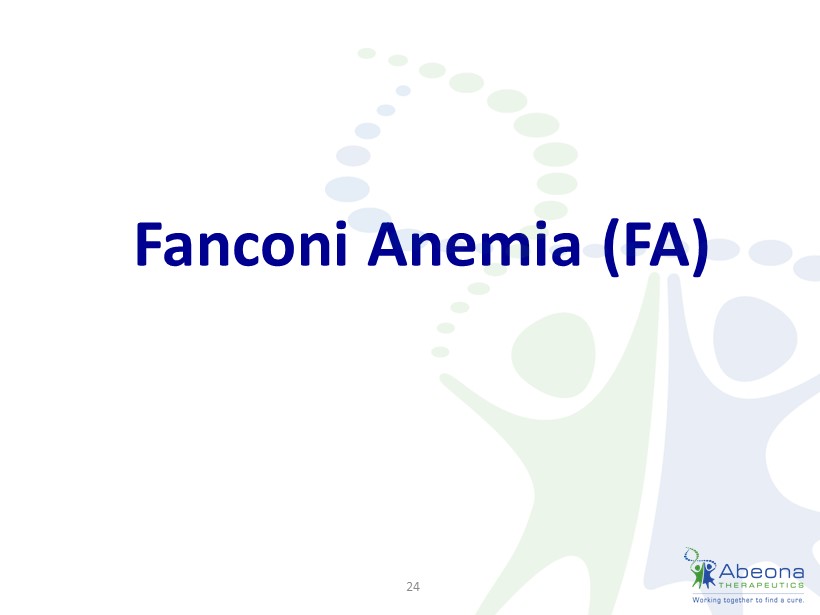
Fanconi Anemia (FA) 24

ABO - 301 (AAV LK19 FANCC) for Fanconi Anemia (FA) • Fanconi anemia (FA) is a rare ( 1: 160,000 ) pediatric, autosomal recessive (inherited) disease • Characterized by multiple physical abnormalities, organ defects, bone marrow failure, and a higher than normal risk of cancer — with 20 to 30 year average lifespan. • The major function of bone marrow is to produce new blood cells. In FA, a DNA mutation renders the FANCC gene nonfunctional. • Loss of FANCC causes patient skeletal abnormalities and leads to bone marrow failure. • Higher rates of hematological diseases, such as acute myeloid leukemia (AML) or tumors of the head, neck, skin, gastrointestinal system, or genital tract. • ABO - 301 (AAV LK19 FANCC) using CRISPR/cas9 in vivo (delivery vector with hematopoetic tropism) demonstrates in vivo efficacy in multiple models, with no off target effects • Next steps : Complete IND enabling pre - clinical studies; and establish safety and preliminary efficacy in human subjects. 25 A 3 - year - old patient with Fanconi anemia. Multiple birth defects, including short stature, microcephaly, microphthalmia , epicanthal folds, dangling thumbs, site of ureteral reimplantation , congenital dislocated hips, and rocker bottom feet. Sources: NCI (2015); Nathan DG, Oski FA, eds. Hematology of Infancy and Childhood, 4th ed. Philadelphia, PA: WB Saunders, Inc , 1993: 216 - 316

Gene Therapy and Rare Disease Comparables 26 resourced from YahooFinance.com as of 11.11.15

PLASMA THERAPY 27

Alpha - 1 Antitrypsin (AAT) Deficiency is a recessive (inherited) disease in which a deficiency of AAT produces COPD and liver disease from retained misfolded AAT • AAT deficiency is a protein folding disease • Protein folding is the process by which an unfolded polypeptide chain folds in to a specific native and functional structure • Misfolding and retention in the ER (endoplasmic r eticulum) leads to aggregation in cells of synthesis Source: J Pediatr . (2013) 163(2): 320 – 326 ; Disorders of Protein Misfolding : Alpha - 1 - antitrypsin Deficiency as Prototype. Teckman , Jain (2013) 16:367; Advances in Alpha - 1 - Antitrypsin Deficiency Liver Disease . Z 28

Sources: AJRCCM 1998; 158:49; Worldwide racial and ethnic distribution of alpha(1) - antitrypsin deficiency. Chest 2002;122:1818 AAT a ugmentation t reatment i mproves morbidity and mortality • AAT deficiency predisposes those affected to COPD and liver disease • AAT treatment i mproves morbidity ( FEV 1 /breathing capacity) and mortality (survival) • First approved in 1988 as weekly i.v. infusion at 60 mg/kg – Four currently approved products: ( Glassia ® ( Kamada ) , Aralast - NP TM ( Baxter Healthcare), Prolastin - C ® ( Grifols ), Zemaira ® (CSL Behring ). • ~10K US patients are currently on AAT augmentation therapy – Estimated 80 - 100K require augmentation in US – ~$1 B market, CAGR 20% – Reimbursed at ~$100K/year, with average of 22 years on treatment – Up to 3% of all people diagnosed with COPD may have undetected AATD Cumulative Mortality AAT augmentation 29

Proprietary SDF Manufacturing process delivers significant advantages over current industry standard Cohn process 30 SDF Delivers… Kinder, gentler x 2 - stage sodium citrate precipitation + diafiltration x Compared with Cohn method: • No ethanol or harmful pH changes • Less denaturing of select proteins • 3 v. 6 day fractionation process Yield improvements x Up to 10 - fold alpha - 1 yield increase x Potential for multiple orphan proteins (IVIG, C1 esterase) Margin improvements x Increase in margins to ~80% v industry standard ~30% with Cohn method Broad Intellectual Property x Three issued US and worldwide patents; additional IP pending

PTB - 101 (SDF Alpha ™ ) Registration Program • Seeking FDA concurrence for registration studies to determine safety and bio - equivalency comparison of PTB - 101 SDF Alpha TM versus approved API in individuals with AATD • Endpoints with weekly 60 mg/kg dosing: • To demonstrate that the pharmacokinetics of antigenic and/or functional PTB - 101 is not inferior to approved active comparator • To measure the efficacy of PTB - 101 maintains antigenic and/or functional plasma levels of at least 11 m M (57 mg/ dL ) • To compare alpha - 1 protease inhibitor (API) trough levels (antigenic and functional) over weeks 7 - 12 (6 infusions) • Study population of n=50 subjects; five week wash - out period prior to dosing • Seeking additional regulatory guidance on potential long term follow up with enhanced dosing and schedules, as well as clinical and/or biomarker surrogate endpoints 31

Leadership & Scientific Advisory Board 32
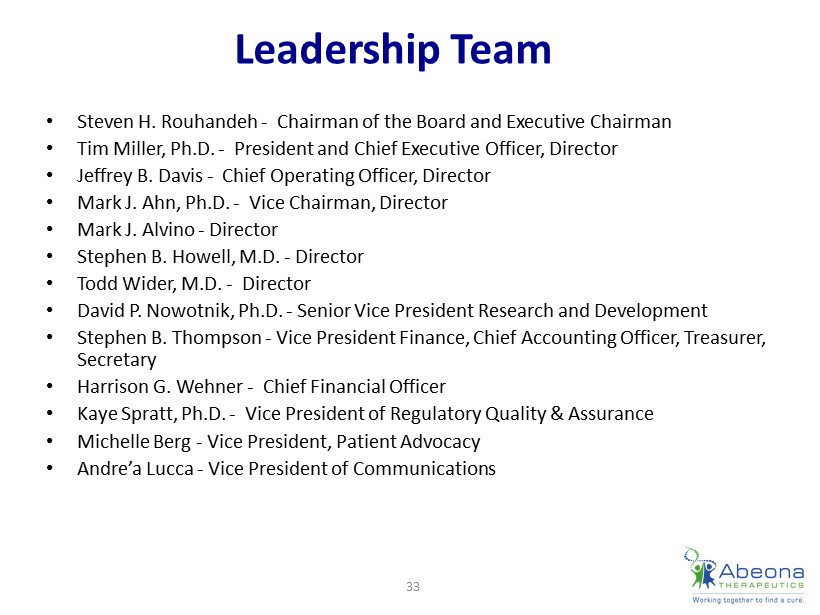
Leadership Team • Steven H. Rouhandeh - Chairman of the Board and Executive Chairman • Tim Miller, Ph.D . - President and Chief Executive Officer, Director • Jeffrey B. Davis - Chief Operating Officer, Director • Mark J. Ahn, Ph.D . - Vice Chairman, Director • Mark J. Alvino - Director • Stephen B. Howell, M.D. - Director • Todd Wider, M.D. - Director • David P. Nowotnik, Ph.D. - Senior Vice President Research and Development • Stephen B. Thompson - Vice President Finance, Chief Accounting Officer , Treasurer , Secretary • Harrison G. Wehner - Chief Financial Officer • Kaye Spratt , Ph.D . - Vice President of Regulatory Quality & Assurance • Michelle Berg - Vice President, Patient Advocacy • Andre’a Lucca - Vice President of Communications 33

Rare Disease Scientific Advisory Board (SAB) Gene Therapy • Barry Byrne, MD, University of Florida, Powell Gene Therapy Center • Carsten Bonnemann , MD, Children’s Hospital of Philadelphia • Pol Boudes , MD, Cymabay Therapeutics • Brian Kaspar , Ph.D , Nationwide Children’s Hospital and Ohio State University • Maria Escolar, MD, MS, University of Pittsburgh Center for Neurodegenerative Disorders Plasma - Based Products • Eugene J. Zurlo , B.S. (Pharmacy), M.S. • Charles H. Heldebrant , Ph.D. • Robert A. Sandhaus , MD, PhD, FCCP, National Jewish Health • Charlie B. Strange, MD, FCCP, Medical University of South Carolina 34
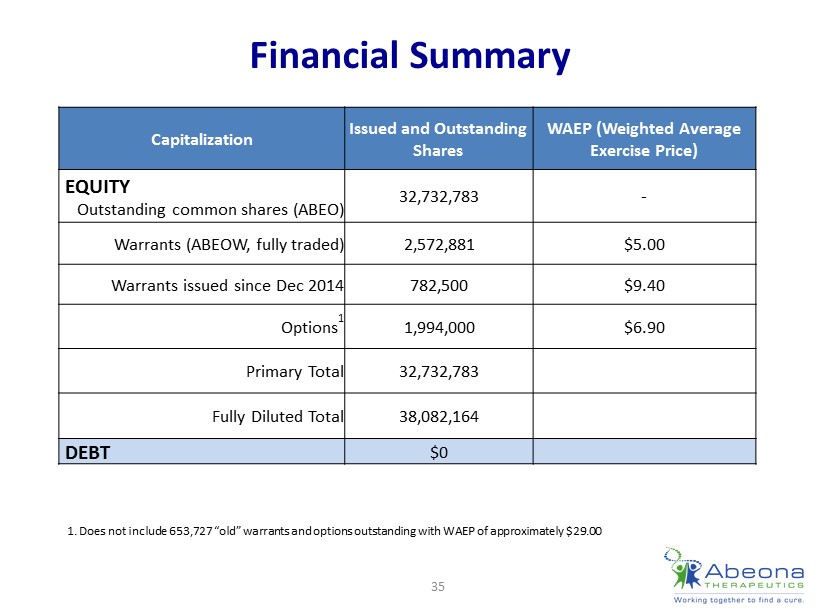
Financial Summary Capitalization Issued and Outstanding Shares WAEP (Weighted Average Exercise Price) EQUITY Outstanding common shares (ABEO) 32,732,783 - Warrants (ABEOW, fully traded) 2,572,881 $5.00 Warrants issued since Dec 2014 782,500 $9.40 Options 1 1,994,000 $6.90 Primary Total 32,732,783 Fully Diluted Total 38,082,164 DEBT $0 35 1. Does not include 653,727 “old” warrants and options outstanding with WAEP of approximately $29.00
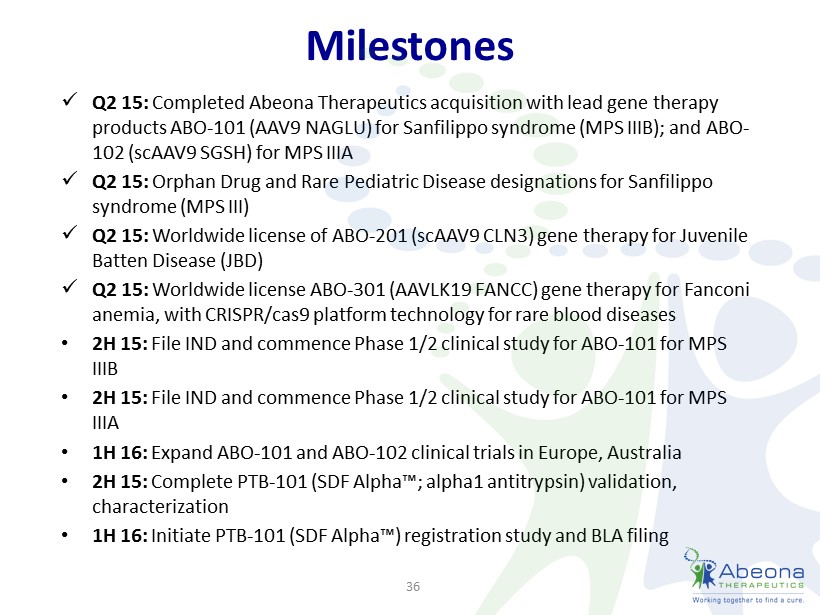
Milestones x Q2 15: Completed Abeona Therapeutics acquisition with lead gene therapy products ABO - 101 (AAV9 NAGLU) for Sanfilippo syndrome (MPS IIIB); and ABO - 102 (scAAV9 SGSH) for MPS IIIA x Q2 15 : Orphan Drug and Rare Pediatric Disease designations for Sanfilippo syndrome (MPS III) x Q2 15: Worldwide license of ABO - 201 (scAAV9 CLN3) gene therapy for Juvenile Batten Disease (JBD) x Q2 15: Worldwide license ABO - 301 (AAVLK19 FANCC) gene therapy for Fanconi anemia, with CRISPR/cas9 platform technology for rare blood diseases • 2H 15: File IND and commence Phase 1/2 clinical study for ABO - 101 for MPS IIIB • 2H 15: File IND and commence Phase 1/2 clinical study for ABO - 101 for MPS IIIA • 1H 16: Expand ABO - 101 and ABO - 102 clinical trials in Europe, Australia • 2H 15: Complete PTB - 101 (SDF Alpha ™; alpha1 antitrypsin) validation, characterization • 1H 16: Initiate PTB - 101 (SDF Alpha ™) registration study and BLA filing 36

Summary • Abeona Therapeutics develops and delivers gene therapy and plasma - based products for severe and life - threatening rare diseases • Innovative, validated and scalable technology platforms for gene therapy and plasma - based products • High value - added rare disease product pipeline: – AB0 - 101 (AA9 NAGLU) and ABO - 102 (scAAV9 SGHG), adeno - associated virus (AAV) - based gene therapies for Sanfilippo syndrome (MPS IIIA and IIIB ) – ABO - 201 (scAAV9 CLN3) gene therapy for juvenile Batten disease (JBD ) – ABO - 301 (AAV LK19 FANCC) for Fanconi anemia (FA) disorder using a novel CRISPR/Cas9 - based gene editing approach to gene therapy program for rare blood diseases. – SDF Alpha™ (alpha - 1 protease inhibitor) for inherited COPD using proprietary SDF™ (Salt Diafiltration ) ethanol - free process • Broad intellectual property (IP), and regulatory exclusivity (Orphan, Rare Pediatric Disease designation), and accelerated development pathways 37

Tim Miller, Ph.D President & CEO Email : tmiller@abeonatherapeutics.com Jeff Davis Chief Operating Officer Email : jdavis@abeonatherapeutics.com Andre’a Lucca Vice - President of Communications Phone : 212.786.6208 Email : alucca @abeonatherapeutics.com Magdalena Tyrpien Director of Investor Relations Phone : 212.786.6209 Email : mtyrpien@abeonatherapeutics.com Contacts
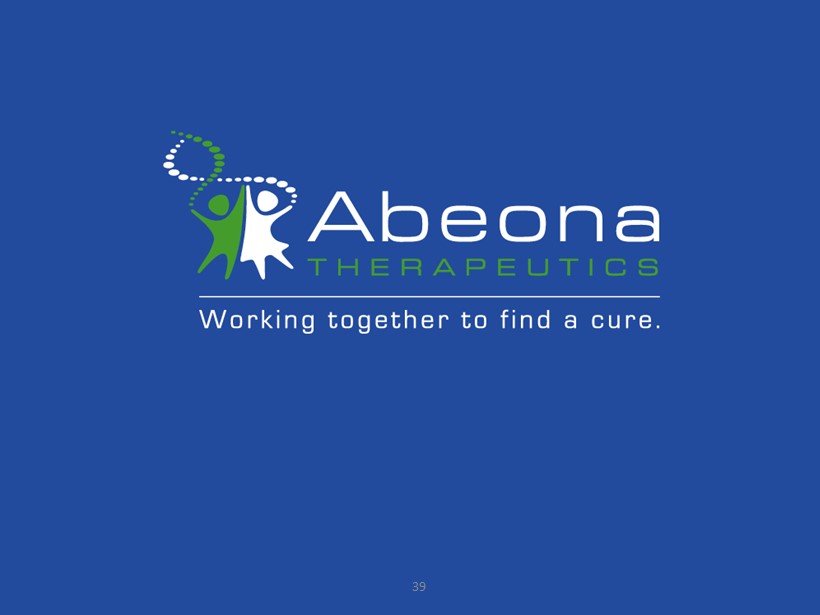
39
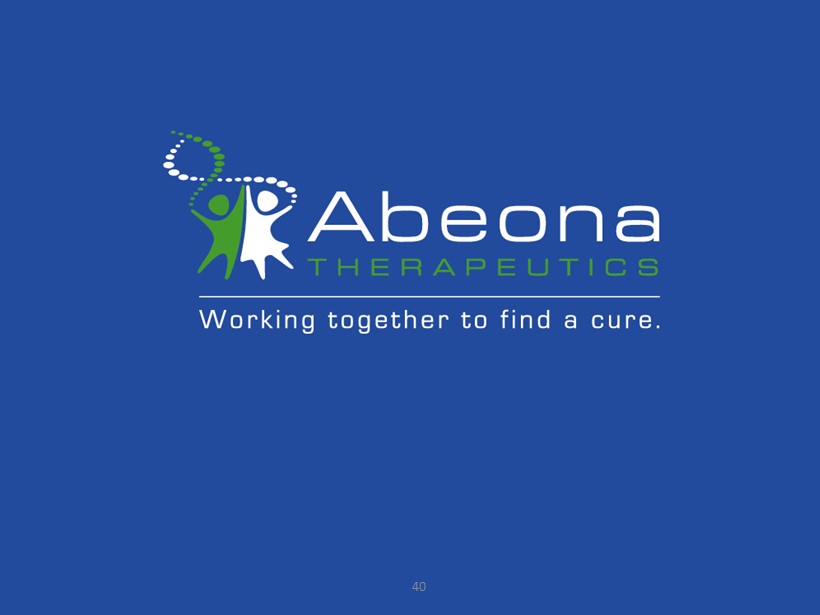
40
